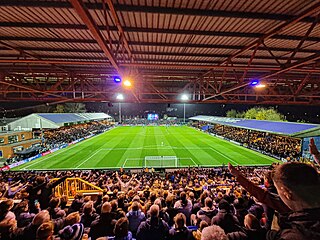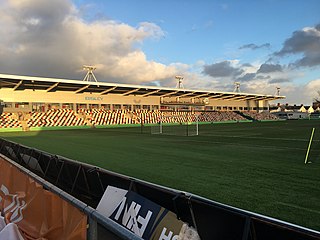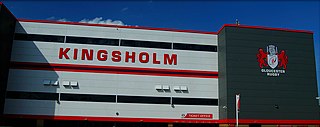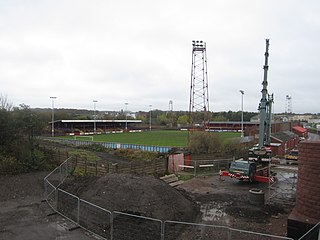Burton United Football Club was a football club based in Burton upon Trent in England. The club was established in 1901 by a merger of Burton Swifts and Burton Wanderers, and played their last competitive season in 1910. In 1924 they merged with Burton All Saints continuing the lineage of the history of football in Burton, while at the same time legally ending the club. Between 1901 and 1907 the club were members of the Football League.

Lansdowne Road Stadium was a stadium in Dublin owned by the Irish Rugby Football Union (IRFU) that was primarily used for rugby union and association football matches. The stadium was demolished in 2007 to make way for the Aviva Stadium on the same site, which opened in 2010.

Edgeley Park is a football stadium in Edgeley, Stockport, England. Built for rugby league club Stockport RFC in 1891, by 1902, the rugby club was defunct and Stockport County Football Club moved in.

Ewood Park is a football stadium in Blackburn, Lancashire, England, and the home of Blackburn Rovers F.C., founding members of the Football League and Premier League, who have played there since 1890. It is an all seater multi-sports facility with a capacity of 31,367, and four sections: the Bryan Douglas Darwen End, Riverside Stand, Ronnie Clayton Blackburn End, and Jack Walker Stand, named after Blackburn industrialist and club supporter, Jack Walker. The football pitch within the stadium measures 115 by 76 yards.

The Newlands Stadium, referred to as DHL Newlands for sponsorship reasons, is located in Cape Town, South Africa. The stadium has a capacity of 51,900 people, but is not an all-seater venue.

Underhill Stadium was a stadium in Chipping Barnet, London, that was the home of Barnet Football Club between 1907 and 2013. The club's under-19 team played fixtures there; it was also the training ground of the London Broncos rugby league club, and hosted Arsenal reserve games until 2012. Before closure the stadium was recorded as having a final capacity of 6,023; it was demolished in 2018, and is now the site of the Ark Pioneer Academy, which opened in 2019. The stadium was famous for its slope from the North to South end.
Burton Wanderers Football Club was a football club based in Burton upon Trent, Staffordshire, England. The club were members of the Football League for three seasons in the mid 1890s. In 1901 they merged with Burton Swifts to form Burton United. The club played at Derby Turn.
Burton Swifts Football Club was a football club based in Burton upon Trent, England. Established in 1871, the club joined the Football League in 1892, remaining members until merging with Burton Wanderers to form Burton United in 1901.

Hindmarsh Stadium is a multi-purpose stadium in Hindmarsh, an inner western suburb of Adelaide, South Australia. It is the home of the Australian A-League team, Adelaide United.

Parramatta Stadium was a sports stadium in Parramatta, New South Wales, Australia, 23 kilometres west of Sydney's central business district. The stadium was the home ground of several western Sydney-based sports teams, at the time of closure the most notable were the Parramatta Eels of the National Rugby League and the Western Sydney Wanderers of the A-League.

The Manor Ground located in Plumstead, south east London was a football stadium. This arena was the home of football club Royal Arsenal, which was later named Woolwich Arsenal, and as so came to be known as Arsenal F.C.

The Athletic Ground, latterly known as the McCain Stadium, was a football stadium located on Seamer Road in Scarborough, North Yorkshire, England. It was the home of Scarborough F.C., a defunct football club who last played in the English Conference North before they were dissolved on 20 June 2007 with debts of £2.5 million.

Rodney Parade is a stadium in the city of Newport, South Wales, owned and operated by the Welsh Rugby Union. It is located on the east bank of the River Usk in Newport city centre. The ground is on Rodney Road, a short walk from the city's central bus and railway stations via Newport Bridge or Newport City footbridge. There is no spectator car park at the ground but a number of multi-storey car parks are nearby.

Kingsholm Stadium is a rugby union stadium located in the Kingsholm area of Gloucester, England, and is the home stadium of Gloucester Rugby. The stadium has a capacity of 16,115. It is sometimes nicknamed 'Castle Grim' after the estate where the stadium is built. The new main grandstand, opened in 2007, is an all seated 7,500 capacity stand along the south touchline. It is currently sponsored by Malvern Tyres.
The Recreation Ground and for sponsorship reasons the LEL Arena is a rugby league stadium in Whitehaven, Cumbria, England. It is the home of Whitehaven R.L.F.C.

Borough Park is a football stadium in Workington, Cumbria, England. The home ground of Workington A.F.C., it has a capacity of 3,101, of which 500 is seated.
Cressing Road, also known as the Dunmow Group Stadium for sponsorship purposes, is a football stadium in Braintree, Essex, and the home ground of Braintree Town, and formally their reserve side. It currently has a capacity of 4,151.

Penrith Stadium is a rugby league and association football stadium located in Penrith, New South Wales, Australia.
Derby Turn was a football and athletics stadium in Burton upon Trent in England. It was the home ground of Burton Wanderers, who played in the Football League during the mid-1890s, and was also used to host athletics meetings.

Western Sydney Stadium, commercially known as CommBank Stadium, is a multi-purpose rectangular stadium located in Parramatta, within Greater Western Sydney region, approximately 24 km (15 mi) west of Sydney City Centre. It replaced the demolished Parramatta Stadium (1986) which in turn was built on the site of the old Cumberland Oval, home ground to the Parramatta Eels since 1947. The current stadium opened in April 2019 and has a 30,000 seat capacity. The stadium is owned by the NSW Government, operated by VenuesLive, designed by Populous Architects, engineered by Aurecon and built by Lendlease with a build cost of $300 million. The stadium hosts games across the major rectangular field sports in Sydney.














